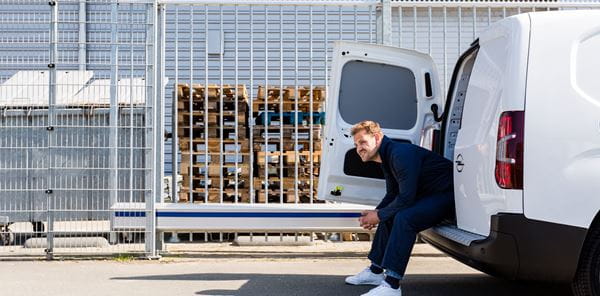
What are the speed limits for vans and pickup trucks?
Commercial vehicle drivers face a more complex set of speed limits than passenger cars, with potentially larger fines for breaking them. Here’s how to keep your fleet safe and legal.
Speeding is a big challenge for fleets. It accounted for a third of motoring convictions in 2021, and Department for Transport data shows van drivers are more likely to break speed limits than people in cars.
With different rules for similar-looking vehicles, severe penalties for non-compliant drivers and new technology on the horizon, the following guide has all the important details for commercial vehicle fleets.
What are the speed limits for car-derived vans?
It’s become a small segment in the UK but, as the name suggests, car-derived vans are based on their passenger-carrying counterparts. These usually have a large, lined load area instead of rear seats and, by law, a gross vehicle weight (GVW) of no more than two tonnes.
Ford has recently discontinued the Fiesta Van, so the only car-derived vans available today are commercial versions of the Dacia Duster and Toyota Corolla. Speed limits are identical to passenger cars, including the restrictions if they are towing a trailer.
- 30mph in built-up areas
- 60mph on single carriageways (50mph if towing)
- 70mph on dual carriageways (60mph if towing)
- 70mph on motorways (60mph if towing)
What are the speed limits for vans?
Commercial vehicles with a GVW of up to 7.5 tonnes all use the same speed limits. These cover all panel vans (which are typically up to 3.5 tonnes), chassis cabs and some light trucks, and with slightly lower limits under some conditions than cars.
- 30mph in built-up areas
- 50mph on single carriageways
- 60mph on dual carriageways
- 70mph on motorways (60mph if towing)
Heavier (over 7.5-tonne GVW) and/or articulated commercial vehicles have the same limits as a van towing a trailer.
What are the speed limits for pickup trucks?
The rules are a more complicated for pickup trucks, as they fall into different categories depending on their unladen weight (kerb weight).
Pickup trucks weighing 2,040kg or less and with two rows of seats are classed as ‘dual-purpose vehicles’. This group includes the Isuzu D-Max and Mitsubishi L200, and they have same speed limits as passenger cars.
- 30mph in built-up areas
- 60mph on single carriageways (50mph if towing)
- 70mph on dual carriageways (60mph if towing)
- 70mph on motorways (60mph if towing)
Single-cab pickups and heavier models, such as the Ford Ranger, SsangYong Musso and Toyota Hilux, follow the same speed limits as vans.
- 30mph in built-up areas
- 50mph on single carriageways
- 60mph on dual carriageways
- 70mph on motorways (60mph if towing)
What are the speed limits for other van-based vehicles?
The criteria are slightly different for other van-based vehicles.
Passenger car speed limits also apply to:
- People-carriers with up to nine seats (including the driver)
- Crew vans with an unladen weight of 2,040kg or less
- Motorhomes with an unladen weight of up to 3,050kg
Light commercial vehicle speed limits apply to:
- Minibuses with ten or more seats, and a length of less than 12 metres
- Crew vans with an unladen weight of more than 2,040kg
- Motorhomes with an unladen weight over 3,050kg
Those speed limits are also subject to towing restrictions.
Are speed limits the same throughout the UK?
No. Although most speed limits are set nationally, there are some variations depending where you’re driving and on the road type.
- Wales will introduce a 20mph urban speed limit in September 2023, replacing almost all of its 30mph zones.
- Scotland didn’t follow reforms in the rest of the UK in 2015, which means commercial vehicles with a GVW over 7.5 tonnes are limited to 40mph on single and 40mph on dual carriageways.
- Variable limits apply to all cars, vans and trucks, as long as drivers don’t exceed the maximum speed for their vehicle type.
- Police forces set their own guidelines for enforcing speed limits, including differing tolerances for inaccurate equipment. Although some will overlook minor offences, it isn’t a chance worth taking. Breaking the limit by 1mph is against the law and drivers can be penalised for doing so.
Do van drivers get bigger fines for speeding?
It’s possible. Drivers caught way over the speed limit, or who plead not guilty, may end up in court, and the fines can be severe. Courts can choose to increase the penalties for the most dangerous offences, such as speeding in heavy vans, poor weather conditions or areas with lots of pedestrians. Drivers could be fined 150% of their pre-tax weekly income, capped at £1,000 (£2,500 on the motorway) and lose their licence if convicted.
This isn’t the norm. Most drivers will get a Fixed Penalty Notice with a £100 fine and have three penalty points added to their licence for four years. If they get 12 penalty points in a three-year period, they can be disqualified.
Police forces can also, at their discretion, offer a speed awareness course as an alternative to penalty points. The criteria and prices vary, but courses typically cost the same as a fine and drivers can’t attend more than one within a three-year period.
Are speed limiters required for cars and vans?
In most cases, no. Speed limiters are required for passenger vehicles with more than nine seats or vans with a GVW of more than 3.5 tonnes. However, the UK has indicated that it follow European Union regulation and make Intelligent Speed Assist (ISA) systems mandatory for all new cars, vans and trucks by 2024.
Depending on the vehicle, ISA will either warn drivers if they are speeding, or actively intervene to bring them back in line. Vehicles can use data from cameras, maps or a combination of both but must recognise when they are in areas with ‘implicit’ speed limits – such as near schools – as well as those which are signposted numerically.
This technology has limits. There is no requirement for ISA to display different speed limit in poor driving conditions or if the vehicle is towing a trailer. Legally, the driver is always responsible for obeying local traffic rules and must be able to override the system when needed.
Important information:
This blog was originally published on leaseplan.com website. The views expressed may no longer be current and any reference to specific vehicles or products is for reference only. This information is not a personal recommendation for any particular vehicle, product or service - if you are unsure about the suitability of a product, you should consult with an expert.



